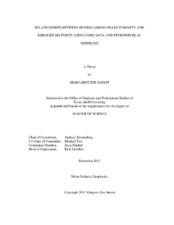| dc.description.abstract | Unconventional shale reservoir core samples analyzed by thermal and solvent extraction methods, analytical techniques, and microstructural observations exhibit strong positive linear relationships between hydrocarbon mobility and imaged pore space with maturity measured by vitrinite reflectance (%Ro). This positive relationship between thermal maturity and porosity differs from porosity-burial relationships governed by mechanical compaction and effective pressure.
Solvent extraction measurements and pyrolysis results indicate that solvent extraction removes both light (mobile) and heavy (immobile) components of bitumen, while thermal extraction fails to remove the immobile portion. Percent image area recognized as pore space in SEM BSE images show that the porosities are considerably lower than extraction predicted porosity measurements (% bulk volume). Thus, primary storage of pore-filling fluids is probably governed by adsorption and absorption.
Unconventional reservoir shale core samples subjected to Dean Stark and retort extractions combined with pyrolysis, performed both before and after extraction, permitted identification and quantification of measurable pore-filling fluids and organic matrix material. X-ray powder diffraction (XRD) provided bulk mineralogical composition information. Microscopic X-ray fluorescence (MicroXRF) revealed bedding patterns and areas of interest on which further imaging was performed. Attempts at identifying organic matter through electron microprobe wavelength-dispersive spectroscopy (WDS) proved unsuccessful due to difficulty imaging carbon and low sulfur counts in the organics. Reflected light microscopy revealed foram shells and fractures acting as storage space for organic matter. Scanning electron microscopy (SEM) was performed on the micron scale in order to image porosity. Secondary electron (SE) images revealed very little about organic porosity, but backscattered electron (BSE) images successfully imaged pore space and provided a means for identifying organic matter based on its low density. Quantification of imaged pore space and organic matter was performed using ImageJ Software and manipulation of lookup table numbers (LUT #). | en |


